Open bite – you want to have it corrected? Here you will find all the information about malocclusion and open bite treatment.
Dentists and orthodontists always speak of a malocclusion when one or more teeth are outside the ideal arch shape of the upper or lower jaw.
For example, the teeth may be rotated, protrude forward or backward, or simply not grow out where they should.
Tooth misalignments have only aesthetic effects in most cases. This means that although they disturb us visually, they do not negatively affect our health.
| Get 150 € discount on your dental correction! |

Book a consultation appointment now at a nearby DrSmile partner practice and find out if teeth straightening with aligners is right for you.
The appointment is completely non-binding and does not involve any costs.
With the code “THATSMILE150” you will receive 150 € discount on the treatment.
In some circumstances, however, crooked teeth can also make it difficult to clean the teeth or interfere with food intake. Speech disorders (e.g. lisp) are also not uncommon.
Serious health consequences are also possible. However, they are usually the result of extreme tooth misalignment.
A common malocclusion is the so-called open bite. It occurs relatively frequently in the primary dentition, but much less frequently in the mixed dentition.
This is a malocclusion in which the incisors do not meet, often creating a clearly visible gap between the lower and upper jaws.
This often bothers those affected for aesthetic reasons. In some cases, however, the misalignment of teeth must also be treated for health reasons.
You can find more information on the topic of open bite as well as treatment options in this article.
Here you can also find out whether discreet treatment with invisible braces (aligners) is possible.
You want to know directly? Then make a free and non-binding consultation appointment here.
You can find a first overview of all malocclusions here.
Many patients have already had their misaligned teeth successfully treated with invisible dental splints. Take a look at their before/after pictures here.

What exactly is an open bite?
The open bite is one of the more common dental malocclusions. Dentists and orthodontists diagnose it when the incisors do not meet.
Because of this, there is a smaller or even larger gap between the upper and lower jaws. This visible gap remains between the rows of teeth even when the canines are pressed firmly together.
In the case of the open bite, a distinction is made between two types:
- The frontal open bite is manifested by a visible gap between the lower and upper incisors. This remains even when the molars and canines are pressed firmly together. The frontal open bite results from adverse behaviors. For this reason, it is also called habitual open bite.
- The skeletal open bite is also called the lateral open bite. This is a genetic predisposition that negatively affects jaw growth.
As a rule, the open bite develops in childhood, which often has a negative effect on speech development.
Affected children begin to lisp when the tongue moves forward into the gap between the incisors.
The incorrect position of the tongue also prevents stimulation of the upper jaw and thus hinders its growth.
This in turn leads to a lack of space in the jaw, so that the front teeth in the lower jaw can grow out crookedly. In this way, a lateral crossbite is favored.
For example, an open bite may look like this:
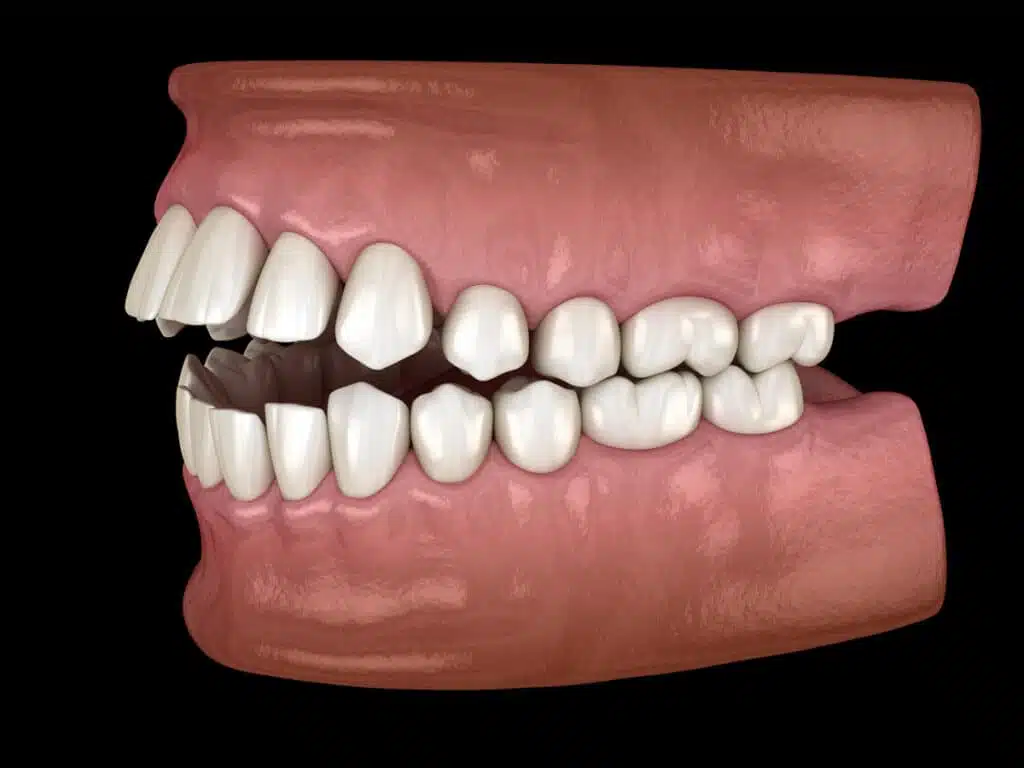
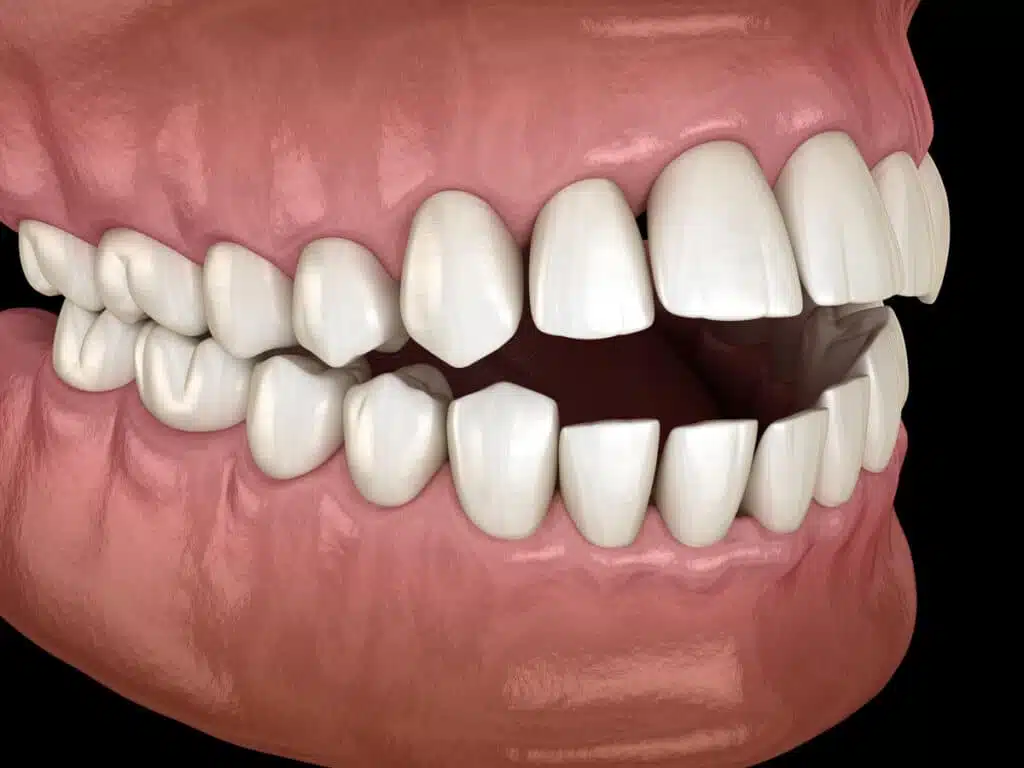
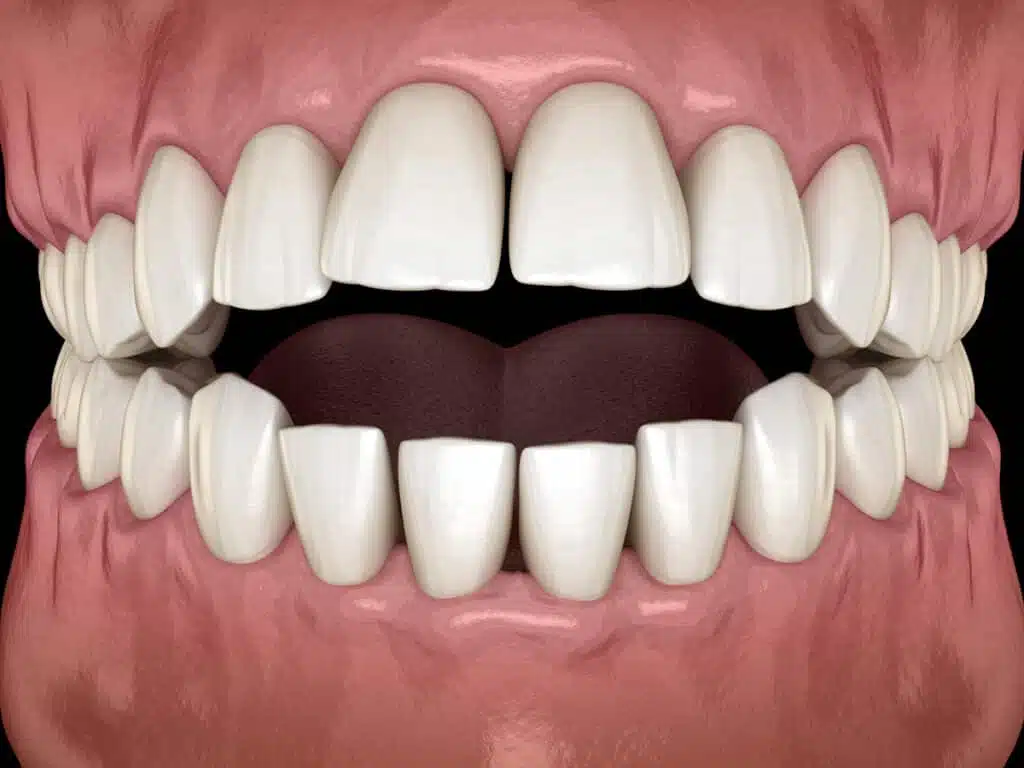
Open bite causes: How does the malocclusion develop?
Depending on whether the open bite is genetic or a result of unfavorable habits, it can have various causes:
- The frontal open bite usually develops in childhood. Causes include intense and prolonged thumb sucking, using the pacifier for too long, cheek sucking or tongue pressing. The frontal open bite can also be favored by a malfunction of the tongue. It often goes undetected and persists into adulthood because it is not noticed by children.
- The skeletal open bite (laterally open bite) is in most cases genetically determined. In this case, the permanent teeth in the posterior region do not have sufficient space, so that only the molars touch each other. This jaw malposition can result in an open bite.
Open bite toddler and open bite pacifier – In this video you will learn more about the topic:
Open bite consequences: What are the health effects?
An open bite can influence the cooperation of tendons, muscles and joints. It can have a negative impact on health and lead to visual impairment.
Possible cosmetic and health consequences may include:
- Lisp and impaired speech development
- Promoting unhealthy mouth breathing
- Dry mouth
- Wear of the temporomandibular joint and temporomandibular joint disorders
- Incomplete lip closure
- Problems with biting and chewing
- Caries
- Irritated throat
- Unaesthetic shaping of the dental arch
The open bite can also lead to further tooth misalignments. It favors crossbite, for example, but occasionally occurs with other bite problems, such as overbite.
Last but not least, a strongly pronounced open bite can lead to a shift in facial proportions. This impairment due to the open bite can in turn lead to psychological problems.
| Get 150 € discount on your dental correction! |

Book a consultation appointment now at a nearby DrSmile partner practice and find out if teeth straightening with aligners is right for you.
The appointment is completely non-binding and does not involve any costs.
With the code “THATSMILE150” you will receive 150 € discount on the treatment.
Open bite treatment: how to proceed?
Especially in the case of a pronounced open bite, treatment is inevitable in order to avoid cosmetic or even health impairments.
There are several options for orthodontic treatment for this. In some cases, complementary logopedic treatment is also useful.
For example, when speech disorders have already become entrenched, patients are permanently breathing through their mouths or their tongues are incorrectly positioned.
Open bite toddler and open bite child: how it is treated
The open bite is particularly uncomplicated to treat in children and adolescents whose jaws are still growing.
Once an open bite has been identified in children, treatment should not be put on the back burner.
This is the only way to prevent speech disorders and long-term health problems such as tooth decay, incorrect loading of the temporomandibular joint or difficult food intake.
Open bite in children can be treated with various orthodontic appliances.
These include the oral vestibular plate, functional orthodontic appliances, fixed braces and various active plates.
Therapy by means of a face mask can always be performed if the lower jaw protrudes far.
Open bite adults: what are the treatment options?
In adults, open bite treatment is somewhat more difficult than in children and adolescents.
Nevertheless, an open bite can and should be corrected at any age. How long the therapy lasts depends on the severity of the malposition.
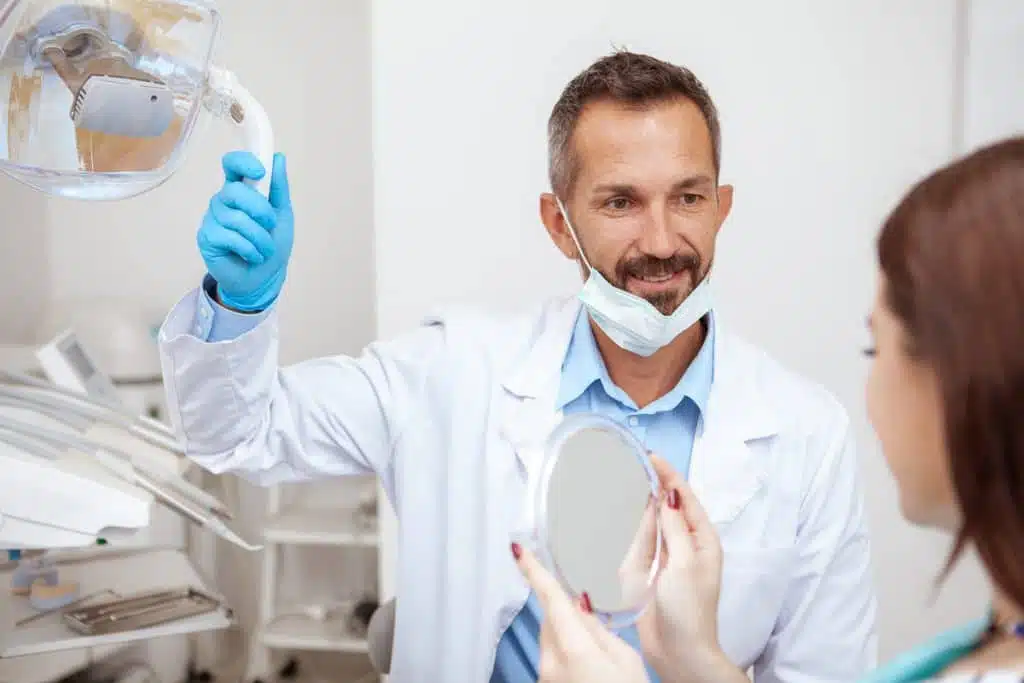
Open bite surgery – when is it necessary?
In some serious cases, open bite surgery may be necessary. This is always the case when correction by fixed braces is no longer possible.
To achieve the desired treatment goal, open bite surgery is usually combined with fixed braces.
Open bite adults without surgery – often braces are enough
If orthodontic measures in childhood were unsuccessful or even missed, fixed braces may be used in adults .
Fixed braces must be worn for several months, in some cases even for several years.
However, quite a few adults fear the limitations of fixed braces in their professional and everyday lives.
Also for aesthetic reasons, fixed braces are an absolute emergency solution for most adults.
In addition, there is the relatively high price. This is because health insurance only covers the costs of overbite treatment in extreme cases.
As a rule, however, open bite treatment for adults must be paid for by the patient, which is often no walk in the park with treatment costs starting at 6000 euros and upwards.
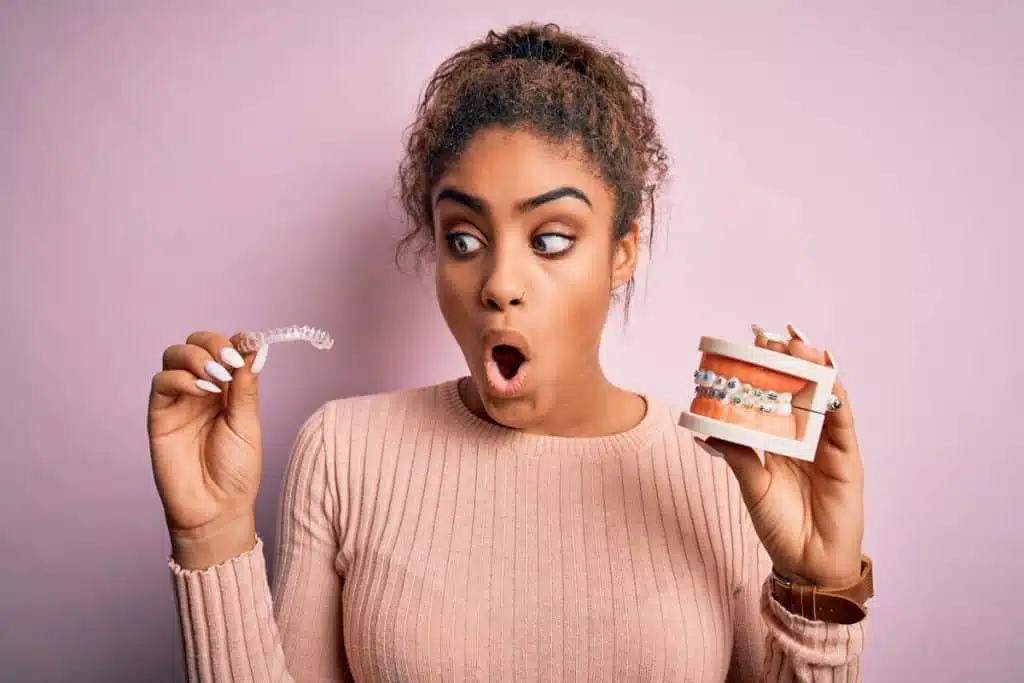
DrSmile: Open bite treatment with invisible braces
In some cases, however, adults can avoid fixed braces. This is because treatment with transparent dental splints is often possible for mild to moderate degrees of tooth misalignment.
These so-called aligners enable discreet tooth correction, as they are completely transparent and fit precisely on the teeth.
They can be removed at any time. However, this is only recommended for eating and daily dental care, as they must be worn for at least 22 hours a day.
Another plus point is the price: the cost of invisible dental trays, for example, starts at just 1790 euros or 33 euros a month with the renowned provider DrSmile.
Here you can find more information about DrSmile prices.
You can find out whether your open bite can be treated with invisible aligners during a free, no-obligation consultation appointment that you can book here.
If regular aligners reach their limits, the invisible braces of Invisalign can treat a more pronounced open bite in some cases.
However, they are significantly more expensive than the products of competitors.
| Get 150 € discount on your dental correction! |

Book a consultation appointment now at a nearby DrSmile partner practice and find out if teeth straightening with aligners is right for you.
The appointment is completely non-binding and does not involve any costs.
With the code “THATSMILE150” you will receive 150 € discount on the treatment.
FAQs on open bite before/after, open bite surgery and more.
Here we answer some frequently asked questions about open bite treatment, open bite surgery and open bite braces.
How painful is jaw surgery?
Jaw surgery is performed under general anesthesia and is accordingly painless and stress-free. The wound left behind, as well as redness and swelling, may be somewhat painful following surgery. With painkillers, however, the unpleasant feeling remains within limits.
What is an open bite?
An open bite is another term for the dental defect “open bite”. This is always the case when the incisal edges of the upper and lower jaws do not meet. Even when the jaws are pressed together, the opening between the rows of teeth remains.
Open bite pacifiers: how harmful are they really?
An open bite caused by the pacifier is especially favored when the child is already 3 years old or older. For this reason, dentists and orthodontists do not recommend “pacifying” for too long.
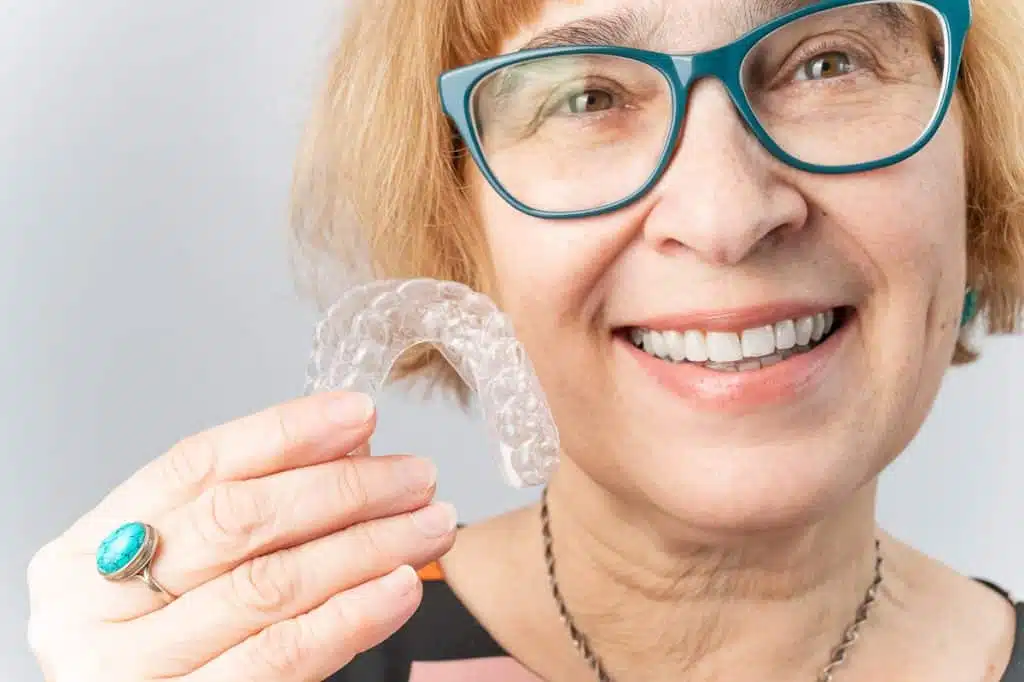
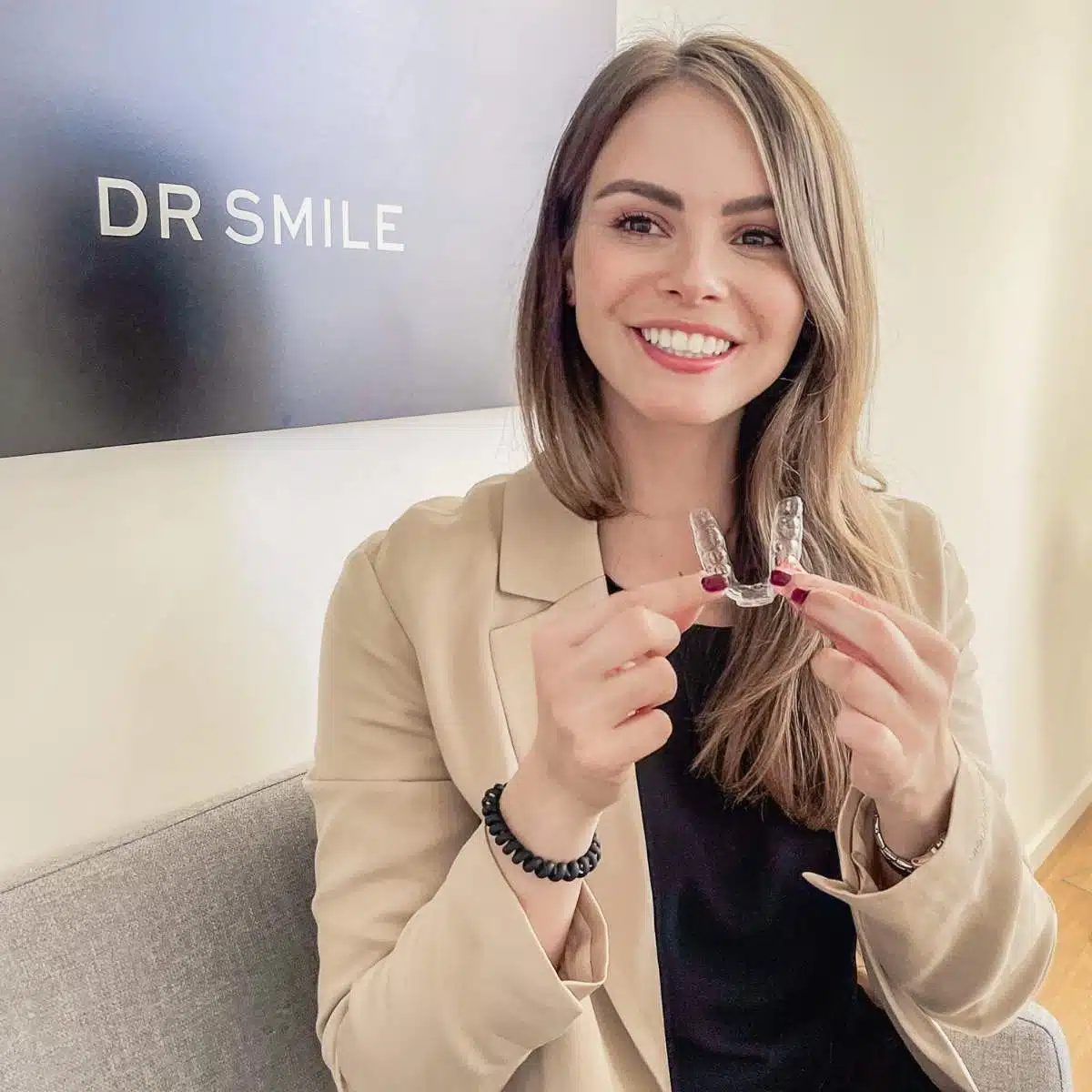
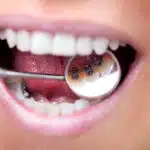
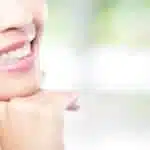
Leave a Reply